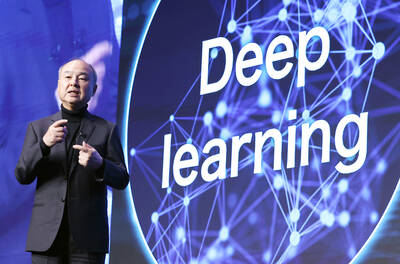E Ink Holdings Inc (元太科技), the world’s only e-paper display supplier, expects revenue to grow explosively next year, fueled by robust demand for e-paper displays used in electronic shelf labels (ESLs) after Walmart Inc joined its peers in introducing digital price tags.
E Ink’s optimism came after its strategic partner, SES-imagotag, on April 27 said that it had entered into a new agreement with Walmart to deploy electronic labels in several hundred Walmart stores in the US.
Initially, a total of 60 million digital shelf labels would be installed at 500 locations over the next 12 to 18 months, SES-imagotag said in a company statement.

Photo: CNA
E Ink has about a 5 percent stake in SES-imagotag.
“Rising labor costs and inflation will prompt retailers to introduce ESLs, as they have to change price tags frequently,” E Ink chairman Johnson Lee (李政昊) told a virtual investors’ conference yesterday.
“With Walmart’s introduction of ESLs, we believe more retailers in North America will follow suit,” Lee said.
E Ink said that it has laid out multiyear capacity expansion plans to cope with growing demand, with its sixth production line in Hsinchu to begin operating next quarter.
Next year, it plans to build a new production line in Hsinchu to produce larger displays used for digital signage, the company said.
In addition to color e-paper displays used in ESLs, the company is making progress in developing large e-paper displays for outdoor and indoor signage, and digital advertisements. It expects to start producing color e-paper displays for outdoor signage later this year using its new Kaleido technology.
It said it also plans to start using its Spectra 6 technology at the end of this year or early next year for indoor signage and advertisements, when its drive IC partners are ready to receive supply.
The company expects revenue to grow by a single-digit percentage year-on-year this year, little changed from its expectations in March, as demand for consumer electronics such as e-readers is weak due to growing macroeconomic uncertainties, E Ink said.
“It will be difficult to see explosive growth this year. We probably have to wait until next year,” Lee said.
This quarter, revenue would only grow mildly from last quarter’s NT$7.23 billion (US$234.61 million), Lee said.
Gross margin would improve from 49.1 percent last quarter, as E Ink expects to ship more materials, which deliver better a margin than modules, Lee said.
In the first quarter, E Ink’s gross margin declined 8.65 percentage points from the fourth quarter of last year to its lowest in about three quarters.
Net profit last quarter expanded 20 percent to NT$1.77 billion, from NT$1.47 billion a year earlier. Last quarter’s net profit was the company’s best first-quarter performance in its history.
Earnings per share climbed to NT$1.54, from NT$1.28 a year earlier.

IN THE AIR: While most companies said they were committed to North American operations, some added that production and costs would depend on the outcome of a US trade probe Leading local contract electronics makers Wistron Corp (緯創), Quanta Computer Inc (廣達), Inventec Corp (英業達) and Compal Electronics Inc (仁寶) are to maintain their North American expansion plans, despite Washington’s 20 percent tariff on Taiwanese goods. Wistron said it has long maintained a presence in the US, while distributing production across Taiwan, North America, Southeast Asia and Europe. The company is in talks with customers to align capacity with their site preferences, a company official told the Taipei Times by telephone on Friday. The company is still in talks with clients over who would bear the tariff costs, with the outcome pending further

NEGOTIATIONS: Semiconductors play an outsized role in Taiwan’s industrial and economic development and are a major driver of the Taiwan-US trade imbalance With US President Donald Trump threatening to impose tariffs on semiconductors, Taiwan is expected to face a significant challenge, as information and communications technology (ICT) products account for more than 70 percent of its exports to the US, Chung-Hua Institution for Economic Research (CIER, 中華經濟研究院) president Lien Hsien-ming (連賢明) said on Friday. Compared with other countries, semiconductors play a disproportionately large role in Taiwan’s industrial and economic development, Lien said. As the sixth-largest contributor to the US trade deficit, Taiwan recorded a US$73.9 billion trade surplus with the US last year — up from US$47.8 billion in 2023 — driven by strong

A proposed 100 percent tariff on chip imports announced by US President Donald Trump could shift more of Taiwan’s semiconductor production overseas, a Taiwan Institute of Economic Research (TIER) researcher said yesterday. Trump’s tariff policy will accelerate the global semiconductor industry’s pace to establish roots in the US, leading to higher supply chain costs and ultimately raising prices of consumer electronics and creating uncertainty for future market demand, Arisa Liu (劉佩真) at the institute’s Taiwan Industry Economics Database said in a telephone interview. Trump’s move signals his intention to "restore the glory of the US semiconductor industry," Liu noted, saying that

AI: Softbank’s stake increases in Nvidia and TSMC reflect Masayoshi Son’s effort to gain a foothold in key nodes of the AI value chain, from chip design to data infrastructure Softbank Group Corp is building up stakes in Nvidia Corp and Taiwan Semiconductor Manufacturing Co (TSMC, 台積電), the latest reflection of founder Masayoshi Son’s focus on the tools and hardware underpinning artificial intelligence (AI). The Japanese technology investor raised its stake in Nvidia to about US$3 billion by the end of March, up from US$1 billion in the prior quarter, regulatory filings showed. It bought about US$330 million worth of TSMC shares and US$170 million in Oracle Corp, they showed. Softbank’s signature Vision Fund has also monetized almost US$2 billion of public and private assets in the first half of this year,